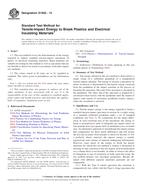Potřebujeme váš souhlas k využití jednotlivých dat, aby se vám mimo jiné mohly ukazovat informace týkající se vašich zájmů. Souhlas udělíte kliknutím na tlačítko „OK“.
ASTM D1822-13
Standard Test Method for Tensile-Impact Energy to Break Plastics and Electrical Insulating Materials
Automaticky přeložený název:
Standardní zkušební metoda pro pevnosti v tahu energii nárazu Break plastů a Elektroizolační materiály
NORMA vydána dne 1.9.2013
Informace o normě:
Označení normy: ASTM D1822-13
Poznámka: NEPLATNÁ
Datum vydání normy: 1.9.2013
Kód zboží: NS-18471
Počet stran: 11
Přibližná hmotnost: 33 g (0.07 liber)
Země: Americká technická norma
Kategorie: Technické normy ASTM
Kategorie - podobné normy:
Anotace textu normy ASTM D1822-13 :
Keywords:
ICS Number Code 29.035.20 (Plastic and rubber insulating materials)
Doplňující informace
| Significance and Use | ||||||||||||||||
|
5.1 Tensile-impact energy is the energy required to break a standard tension-impact specimen in tension by a single swing of a standard calibrated pendulum under a set of standard conditions (see Note 2). To compensate for the minor differences in cross-sectional area of the specimens, the energy to break is normalized to units of kilojoules per square metre (or foot-pounds-force per square inch) of minimum cross-sectional area. An alternative approach to normalizing the impact energy that compensates for these minor differences and still retains the test unit as joules (foot-pounds) is shown in Section 5.1.1 With the Type S (short) specimen the extension is comparatively low, while with the Type L (long) specimen the extension is comparatively high. In general, the Type S specimen (with its greater occurrence of brittle fracture) gives greater reproducibility, but less differentiation among materials. 5.2 Scatter of data is sometimes
attributed to different failure mechanisms within a group of
specimens. Some materials exhibit a transition between different
failure mechanisms. If so, the elongation will be critically
dependent on the rate of extension encountered in the test. The
impact energy values for a group of such specimens will have an
abnormally large dispersion.
5.2.1 Some materials retract at failure with insignificant permanent set. With such materials, determining the type of failure, ductile or brittle, by examining the broken pieces is difficult, if not impossible. It is helpful to sort a set of specimens into two groups by observing the broken pieces to ascertain whether or not there was necking during the test. Qualitatively, the strain rates encountered here are intermediate between the high rate of the Izod test of Test Methods D256 and the low rate of usual tension testing in accordance with Test Method D638. 5.3 The energy for fracture is a function of the force times the distance through which the force operates. Therefore, given the same specimen geometry, it is possible that one material will produce tensile-impact energies for fracture due to a large force associated with a small elongation, and another material will produce the same energy for fracture result due to a small force associated with a large elongation. It shall not be assumed that this test method will correlate with other tests or end uses unless such a correlation has been established by experiment. 5.4 Comparisons among specimens from different sources are to be made with confidence only to the extent that specimen preparation, for example, molding history, has been precisely duplicated. Comparisons between molded and machined specimens must not be made without first establishing quantitatively the differences inherent between the two methods of preparation. 5.5 Only results from specimens of nominally equal thickness and tab width shall be compared unless it has been shown that the tensile-impact energy normalized to kilojoules per square metre (or foot-pounds-force per square inch) of cross-sectional area is independent of the thickness over the range of thicknesses under consideration. 5.6 The bounce of the crosshead supplies part of the energy to fracture test specimen (see 5.7 For many materials, there are specifications that require the use of this test method, but with some procedural modifications that take precedence when adhering to the specification. Therefore, it is advisable to refer to that material specification before using this test method. Table 1 of Classification System D4000 lists the ASTM materials standards that currently exist. |
||||||||||||||||
| 1. Scope | ||||||||||||||||
|
1.1 This test method covers the determination of the energy required to rupture standard tension-impact specimens of plastic or electrical insulating materials. Rigid materials are suitable for testing by this method as well as specimens that are too flexible or thin to be tested in accordance with other impact test methods. 1.2 The values stated in SI units are to be regarded as standard. The values given in parentheses are for information only. 1.3 This standard does not
purport to address all of the safety problems, if any, associated
with its use. It is the responsibility of the user of this standard
to establish appropriate safety and health practices and determine
the applicability of regulatory limitations prior to use.
|
||||||||||||||||
| 2. Referenced Documents | ||||||||||||||||
|
Doporučujeme:
Aktualizace technických norem
Chcete mít jistotu, že používáte pouze platné technické normy?
Nabízíme Vám řešení, které Vám zajistí měsíční přehled o aktuálnosti norem, které používáte.
Chcete vědět více informací? Podívejte se na tuto stránku.




 Cookies
Cookies
